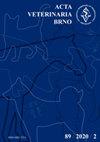Neopterin, procalcitonin, total sialic acid, paraoxonase-1 and selected haematological indices in calves with aspiration pneumonia
IF 0.7
4区 农林科学
Q3 VETERINARY SCIENCES
引用次数: 5
Abstract
This study aims to determine serum neopterin, procalcitonin, total sialic acid (TSA), paraoxonase-1 (PON1), and some haematological indices in calves with aspiration pneumonia (ASP). The patient group consisted of 30 calves of the Simmental breed, 0–28 days old, diagnosed with ASP upon clinical examination, anamnesis, auscultation examination, and radiographic results. The control group consisted of 10 healthy calves, otherwise with the same characteristics. A significant difference was found between calves with ASP and the control group of calves in serum iron (Fe, P < 0.001), total iron-binding capacity (TIBC, P < 0.05), PON1, TSA, procalcitonin, neopterin, and total leukocyte count (WBC) indices as a result of the analyses (P < 0.001). Serum procalcitonin concentration was found to be 285.71 ng/ml in the ASP group and 30.34 ng/ml in the control group. Serum neopterin concentration was found to be 37.68 nmol/l in the ASP group and 15.14 nmol/l in the control group. Serum procalcitonin, neopterin, and TSA concentrations were found to be significantly higher in the ASP group compared to the control group. It was concluded that biomarkers such as serum procalcitonin, neopterin, and TSA are high in calves with ASP, and as a result, these markers provide diagnostically and prognostically important information.吸入性肺炎犊牛的新蝶呤、降钙素原、总唾液酸、对氧磷酶-1和选定血液学指标
本研究旨在测定吸入性肺炎(ASP)犊牛血清新蝶呤、降钙素原、总唾液酸(TSA)、对氧磷酶-1 (PON1)及一些血液学指标。患者组为30头西门塔尔犊牛,0-28日龄,经临床检查、记忆、听诊及影像学检查诊断为ASP。对照组为10头健康犊牛,其余特征相同。结果表明,ASP组犊牛血清铁(Fe, P < 0.001)、总铁结合力(TIBC, P < 0.05)、PON1、TSA、降钙素原、新蝶呤、白细胞总数(WBC)等指标与对照组犊牛差异显著(P < 0.001)。ASP组血清降钙素原浓度为285.71 ng/ml,对照组为30.34 ng/ml。ASP组血清新蝶呤浓度为37.68 nmol/l,对照组为15.14 nmol/l。与对照组相比,ASP组血清降钙素原、新蝶呤和TSA浓度显著升高。结果表明,血清降钙素原、新蝶呤素和TSA等生物标志物在ASP犊牛中含量较高,这些标志物为ASP犊牛的诊断和预后提供了重要信息。
本文章由计算机程序翻译,如有差异,请以英文原文为准。
求助全文
约1分钟内获得全文
求助全文
来源期刊

Acta Veterinaria Brno
农林科学-兽医学
CiteScore
1.00
自引率
33.30%
发文量
36
审稿时长
18-36 weeks
期刊介绍:
ACTA VETERINARIA BRNO is a scientific journal of the University of Veterinary and Pharmaceutical Sciences in Brno, Czech Republic.
The scientific journal Acta Veterinaria Brno is dedicated to the publication of original research findings and clinical observations in veterinary and biomedical sciences. Original scientific research articles reporting new and substantial contribution to veterinary science and original methods that have not been submitted for publication elsewhere are considered for publication. A written statement to this effect should accompany the manuscript, along with approval for publication by the author´s head of department. The authors bear full responsibility for the contents of their contribution. Book reviews are published, too.
 求助内容:
求助内容: 应助结果提醒方式:
应助结果提醒方式:


